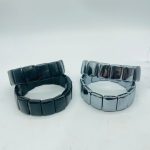In the world of decorative arts, crystal stands as a testament to the transformative power of light and craftsmanship. This versatile and captivating material has adorned palaces, cathedrals, and homes for centuries, adding an air of sophistication and ethereal beauty to any space.

Unlocking the Essence of Crystal
Crystals are naturally occurring minerals that possess a crystalline structure, meaning they are composed of regularly arranged atoms or molecules. This orderly arrangement gives crystals their characteristic brilliance and ability to reflect and refract light.
The most commonly used decorative crystals include:
- Crystal glass: A high-quality, lead-free glass that mimics the clarity and sparkle of natural crystal.
- Lead crystal: A type of glass that contains lead oxide, resulting in a heavier, more brilliant, and more resonant material.
- Quartz crystal: A naturally occurring mineral that is often cut and polished for decorative purposes.
Applications of Decorative Crystal
The versatility of decorative crystal has led to its widespread use in a variety of applications:
- Architecture and interior design: Crystal chandeliers, sconces, and fixtures illuminate grand halls and create a dramatic focal point in living rooms and bedrooms.
- Jewelry: Crystal beads, pendants, and earrings add a touch of sparkle and elegance to any outfit.
- Collectibles: Fine crystal sculptures, vases, and figurines are prized by collectors and enthusiasts around the globe.
- Religious artifacts: Crystal is often used to create liturgical objects, such as chalices, crucifixes, and prayer beads.
- Scientific instruments: Crystal is utilized in prisms, lenses, and other optical devices due to its exceptional light-bending properties.
Inspiring Innovations with Decorative Crystal
The creative potential of decorative crystal is boundless. Designers and artists are constantly exploring new ways to harness its beauty and functionality:
- Crystal fiber optics: Thin strands of crystal guide light over long distances, providing innovative lighting solutions for architectural and scientific applications.
- Crystal printing: Three-dimensional printing technology is now being used to create complex and intricate crystal objects that were previously impossible to produce.
- Crystal sensors: Researchers are developing crystal-based sensors that can detect and monitor gases, pollutants, and biological substances with unprecedented accuracy.
Market Trends and Innovations
The global decorative crystal market is projected to reach $20 billion by 2026, driven by:
- Increasing demand for luxury home décor and accessories.
- The rise of e-commerce and online marketplaces.
- Growing interest in sustainable and eco-friendly materials.
Innovative Trends:
- Art deco revival: Crystal is experiencing a resurgence in popularity as Art Deco designs inspire modern interiors.
- Personalized crystal: Designers are offering custom-designed crystal pieces that reflect individual preferences and styles.
- Crystal in architectural lighting: Architects are embracing crystal as a durable and eye-catching material for exterior and interior lighting installations.
Choosing Decorative Crystal: A Buyer’s Guide
When selecting decorative crystal, consider the following factors:
- Purpose: Determine the intended use of the crystal piece, whether for display, lighting, or everyday use.
- Material: Choose from crystal glass, lead crystal, or quartz crystal based on the desired weight, brilliance, and durability.
- Design: Select crystal pieces that complement your existing décor and personal style.
- Quality: Look for crystal that is free of imperfections, scratches, or bubbles.
- Budget: Set a realistic budget and research prices from different retailers.
Strategies for Caring for Decorative Crystal
Preserving the beauty and longevity of decorative crystal requires proper care:
- Cleaning: Use a soft, damp cloth or specially formulated crystal cleaner to remove dust and dirt.
- Polishing: Occasionally polish crystal with a cotton cloth and a non-abrasive polishing compound.
- Storage: Store crystal in a cool, dry place away from direct sunlight and heat.
- Handling: Handle crystal carefully to avoid scratches or breakage.
- Insurance: Consider insuring valuable crystal pieces for peace of mind.
Effective Tips:
- Use microfiber cloths to prevent scratching.
- Avoid exposing crystal to extreme temperatures or harsh chemicals.
- Protect crystal from sharp objects and abrasive surfaces.
- Refrain from washing crystal in the dishwasher.
Step-by-Step Guide to Creating a Crystal Chandelier
- Gather materials: Crystal prisms, light fixtures, wire, and electrical components.
- Design the chandelier: Sketch out the desired shape and size of the chandelier.
- Drill holes in the prisms: Use a diamond-tipped drill bit to create holes for the wire.
- Assemble the chandelier: Connect the prisms to the light fixture using the wire.
- Install the chandelier: Mount the chandelier to the ceiling and connect it to the electrical supply.
Tables:
Table 1: Types of Decorative Crystal
| Type | Material | Characteristics |
|---|---|---|
| Crystal glass | High-quality, lead-free glass | Clarity, sparkle, affordable |
| Lead crystal | Glass with lead oxide | Brilliance, resonance, heavy |
| Quartz crystal | Naturally occurring mineral | Translucent, durable, metaphysical properties |
Table 2: Applications of Decorative Crystal
| Application | Function | Example |
|---|---|---|
| Architecture and interior design | Illuminate and enhance spaces | Chandeliers, sconces |
| Jewelry | Add sparkle and elegance | Beads, pendants, earrings |
| Collectibles | Display and admire | Crystal sculptures, vases |
| Religious artifacts | Worship and ceremony | Chalices, crucifixes |
| Scientific instruments | Guide and manipulate light | Prisms, lenses |
Table 3: Market Trends for Decorative Crystal
| Trend | Driver |
|---|---|
| Art deco revival | Nostalgia for 1920s and 1930s design |
| Personalized crystal | Individual expression and exclusivity |
| Crystal in architectural lighting | Durability, aesthetics, innovation |
Table 4: Caring for Decorative Crystal
| Task | Instructions |
|---|---|
| Cleaning | Use a soft, damp cloth or crystal cleaner |
| Polishing | Polish with a cotton cloth and non-abrasive compound |
| Storage | Keep in a cool, dry place away from sunlight and heat |
| Handling | Handle carefully to avoid scratches or breakage |
| Insurance | Consider insurance for valuable pieces |




























